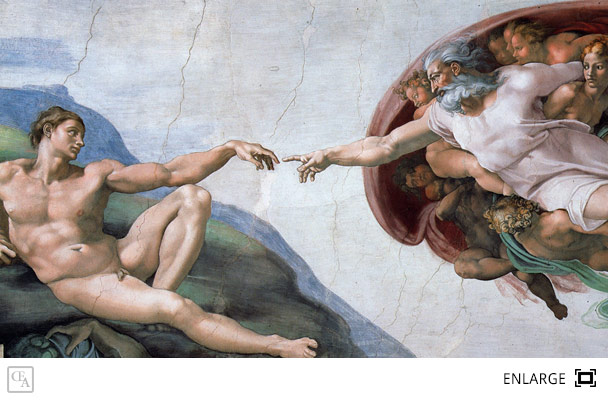
It depicts the birth of the Biblical Adam according to the passage in the book of Genesis. It is considered a major work of the High Renaissance, and was commissioned by Pope Julius II during the same time that Michelangelo was working on the Pope's tomb.
This scene is one of the most famous of the vast ceiling paintings of Michelangelo in the Sistine Chapel, and it can be found near a similar detail, The Creation of Eve, as well as another major scene Congregation of the Waters.
Michelangelo's depiction of Adam's creation is quite different from other Creation-related works that existed before it. In this image, God and Adam face each other, God floating in the sky surrounded by angelic figures and flowing fabric that waves in the wind. Some have noticed that the red fabric that surrounds the celestial characters resembles a human uterus, and it is possible, given Michelangelo's knowledge of anatomy, that this may have in fact been intended as a symbol of creation and fertility.
In the image, God appears old, as a fatherly figure with a large gray beard, but his body is youthful and muscular, giving off an impression of power. This depiction of God with a powerful, organic body thrusting forward in raw action is very different from the typical images of God as static royalty, often ruling from a throne, that was common in the Western art. Instead of a King's attire, he's wearing simple garments that expose the skin of his arms and legs. In a sense, this seems to make God more human-like, more personal, less removed from mankind and more involved with the occurrences on Earth.
In contrast to God's determined action, Adam reclines lazily and reaches out casually to meet the Creator's touch. This divine touch is meant to portray the first spark of life that God gave to the human race. Both figures have physical similarities, in their posture and in the shape of their bodies, which seems to reflect the notion that God created mankind in his image.
A subject of speculation in regards to this image is the identity of the other characters that appear in the drapery surrounding God. For example, there is a feminine figure that appears directly underneath God's left arm and looks on towards Adam. Generally, she is believed to be Eve, existing in spirit as she anticipates her own creation through Adam's body, but some believe that she could, in fact, be Mary, mother of Jesus, and that the child to her left, whose shoulder God is grazing with his fingers, could be Jesus himself. If this speculation is indeed true, then the scene is highly symbolic and is a foreshadowing of the coming of Christ that will ultimately rescue mankind from the original sin of Adam. It is also possible that the figure is simply an Angel with particularly feminine looks and that she has no special significance.
 Arts3 Network
Website edition
Arts3 Network
Website edition